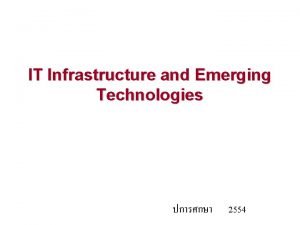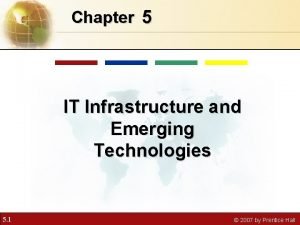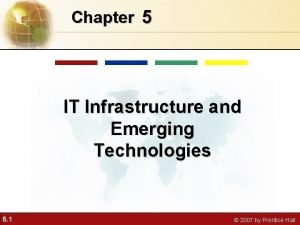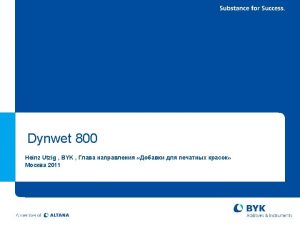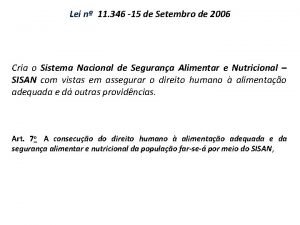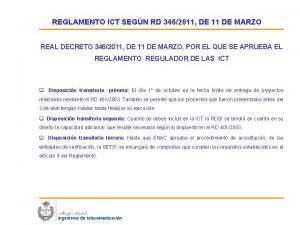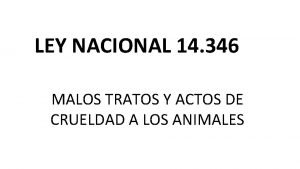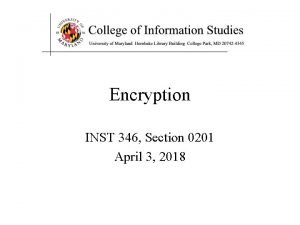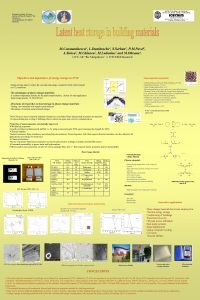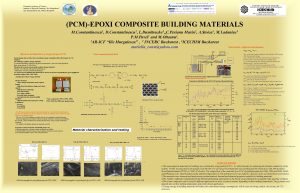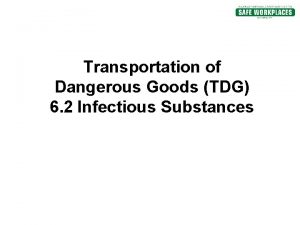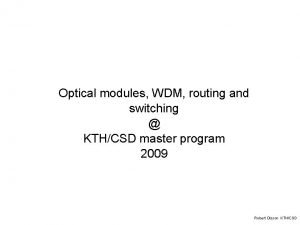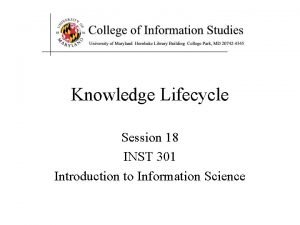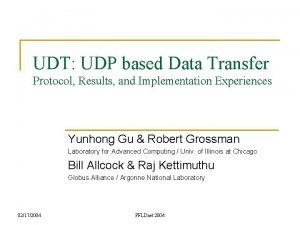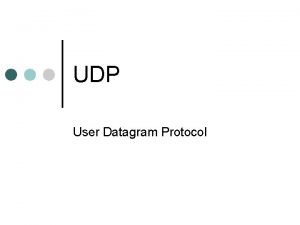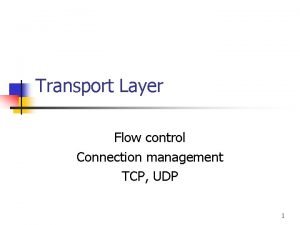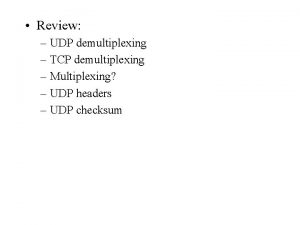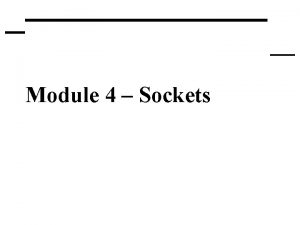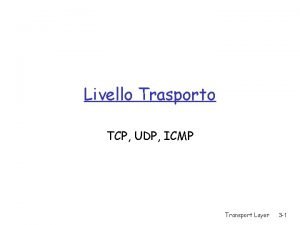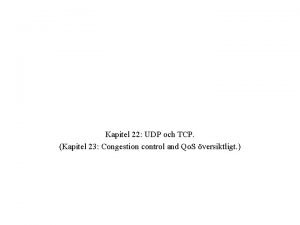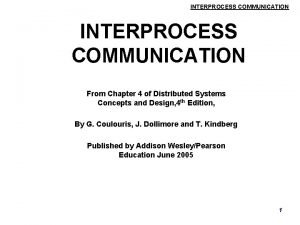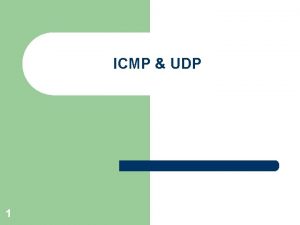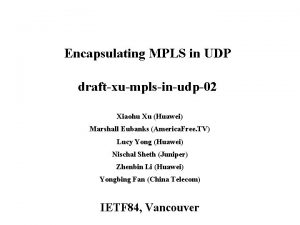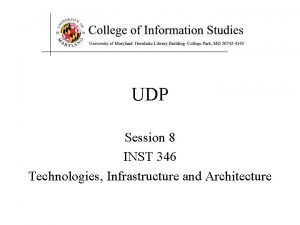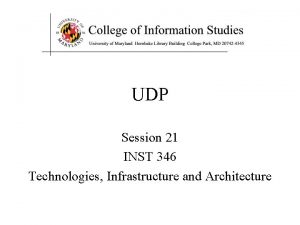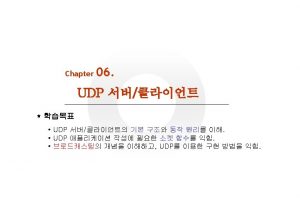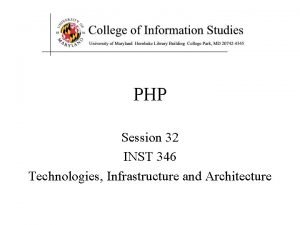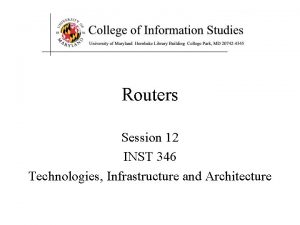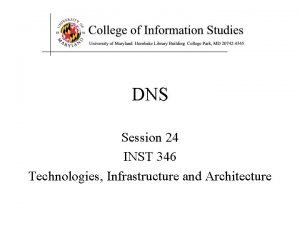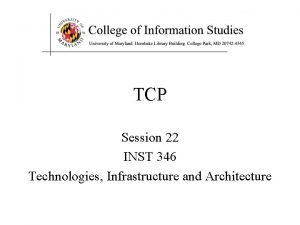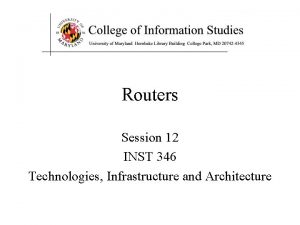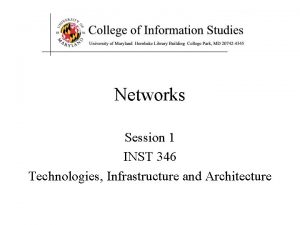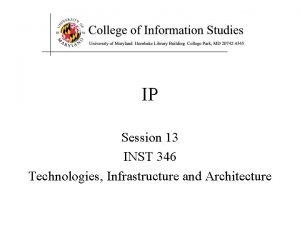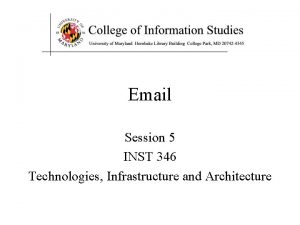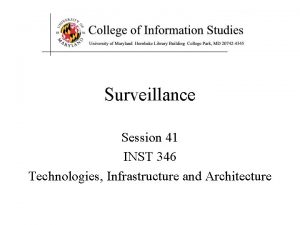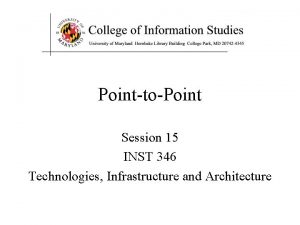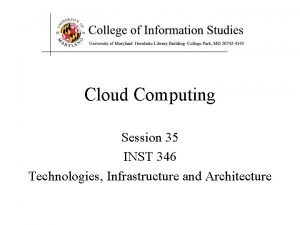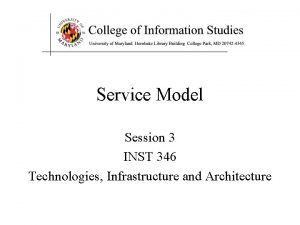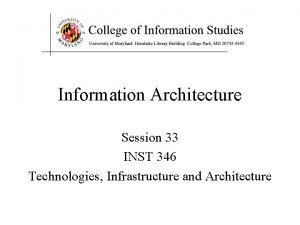UDP Session 8 INST 346 Technologies Infrastructure and









![UDP: User Datagram Protocol [RFC 768] § “no frills” Internet transport protocol § “best UDP: User Datagram Protocol [RFC 768] § “no frills” Internet transport protocol § “best](https://slidetodoc.com/presentation_image/e9d3a7fcb1c01fdde23d611e64a3f8f8/image-10.jpg)






























- Slides: 40

UDP Session 8 INST 346 Technologies, Infrastructure and Architecture

Goals for Today • Questions on L 2 • The role of the network layer • UDP • TCP Part 1

Chapter 3: Transport Layer our goals: § understand principles behind transport layer services: • multiplexing, demultiplexing • reliable data transfer • flow control • congestion control § learn about Internet transport layer protocols: • UDP: connectionless transport • TCP: connectionoriented reliable transport • TCP congestion control

Transport services and protocols nd -e nd le ca gi lo rt po ns tra § provide logical communication between app processes running on different hosts § transport protocols run in end systems • send side: breaks app messages into segments, passes to network layer • rcv side: reassembles segments into messages, passes to app layer § more than one transport protocol available to apps application transport network data link physical

Transport vs. network layer § network layer: logical communication between hosts § transport layer: logical communication between processes • relies on, enhances, network layer services household analogy: 12 kids in Ann’s house sending letters to 12 kids in Bill’s house: § hosts = houses § processes = kids § app messages = letters in envelopes § transport protocol = Ann and Bill who demux to inhouse siblings § network-layer protocol = postal service

Multiplexing/demultiplexing at sender: handle data from multiple sockets, add transport header (later used for demultiplexing) demultiplexing at receiver: use header info to deliver received segments to correct socket application P 1 P 2 application P 3 transport P 4 transport network link network physical link physical socket process

How demultiplexing works § host receives IP datagrams • each datagram has source IP address, destination IP address • each datagram carries one transport-layer segment • each segment has source, destination port number § host uses IP addresses & port numbers to direct segment to appropriate socket 32 bits source port # dest port # other header fields application data (payload) TCP/UDP segment format

Connectionless demultiplexing § created socket has hostlocal port #: Datagram. Socket my. Socket 1 = new Datagram. Socket(12534); § when host receives UDP segment: • checks destination port # in segment • directs UDP segment to socket with that port # when creating datagram to send into UDP socket, must specify • destination IP address • destination port # IP datagrams with same destination port #, but different source IP addresses and/or source port numbers will be directed to same socket at destination

Connectionless demux: example Datagram. Socket my. Socket 2 = new Datagram. Socket (9157); Datagram. Socket server. Socket = new Datagram. Socket (6428); application Datagram. Socket my. Socket 1 = new Datagram. Socket (5775); P 1 application P 3 P 4 transport network link physical source port: 6428 dest port: 9157 source port: 9157 dest port: 6428 source port: ? dest port: ?
![UDP User Datagram Protocol RFC 768 no frills Internet transport protocol best UDP: User Datagram Protocol [RFC 768] § “no frills” Internet transport protocol § “best](https://slidetodoc.com/presentation_image/e9d3a7fcb1c01fdde23d611e64a3f8f8/image-10.jpg)
UDP: User Datagram Protocol [RFC 768] § “no frills” Internet transport protocol § “best effort” service, UDP segments may be: • lost • delivered out-of-order to app § connectionless: • no handshaking between UDP sender, receiver • each UDP segment handled independently of others § UDP use: § streaming multimedia apps (loss tolerant, rate sensitive) § DNS § Vo. IP § reliable transfer over UDP: § add reliability at application layer § application-specific error recovery

UDP: segment header 32 bits source port # dest port # length checksum application data (payload) UDP segment format length, in bytes of UDP segment, including header why is there a UDP? § no connection establishment (which can add delay) § simple: no connection state at sender, receiver § small header size § no congestion control: UDP can blast away as fast as desired

UDP checksum Goal: detect “errors” (e. g. , flipped bits) in transmitted segment sender: receiver: § treat segment contents, including header fields, as sequence of 16 -bit integers § checksum: addition (one’s complement sum) of segment contents § sender puts checksum value into UDP checksum field § compute checksum of received segment § check if computed checksum equals checksum field value: • NO - error detected • YES - no error detected. But maybe errors nonetheless?

Internet checksum: example: add two 16 -bit integers 1 1 0 0 1 1 1 0 1 0 1 wraparound 1 1 0 1 1 sum 1 1 0 1 1 0 0 checksum 1 0 0 0 0 1 1 Note: when adding numbers, a carryout from the most significant bit needs to be added to the result * Check out the online interactive exercises for more examples: http: //gaia. cs. umass. edu/kurose_ross/interactive/

Connection-oriented demux § TCP socket identified by 4 -tuple: • • source IP address source port number dest IP address dest port number § demux: receiver uses all four values to direct segment to appropriate socket § server host may support many simultaneous TCP sockets: • each socket identified by its own 4 -tuple § web servers have different sockets for each connecting client • non-persistent HTTP will have different socket for each request

Connection-oriented demux: example application P 4 P 3 P 5 application P 6 P 3 P 2 transport network link physical host: IP address A transport server: IP address B source IP, port: B, 80 dest IP, port: A, 9157 source IP, port: A, 9157 dest IP, port: B, 80 three segments, all destined to IP address: B, dest port: 80 are demultiplexed to different sockets physical source IP, port: C, 5775 dest IP, port: B, 80 source IP, port: C, 9157 dest IP, port: B, 80 host: IP address C

Connection-oriented demux: example threaded server application P 3 application P 4 P 3 P 2 transport network link physical host: IP address A transport server: IP address B source IP, port: B, 80 dest IP, port: A, 9157 source IP, port: A, 9157 dest IP, port: B, 80 physical source IP, port: C, 5775 dest IP, port: B, 80 source IP, port: C, 9157 dest IP, port: B, 80 host: IP address C

Principles of reliable data transfer § important in application, transport, link layers § characteristics of unreliable channel will determine complexity of reliable data transfer protocol (rdt)

Principles of reliable data transfer § important in application, transport, link layers • top-10 list of important networking topics! § characteristics of unreliable channel will determine complexity of reliable data transfer protocol (rdt)

Principles of reliable data transfer § important in application, transport, link layers • top-10 list of important networking topics! § characteristics of unreliable channel will determine complexity of reliable data transfer protocol (rdt)

Reliable data transfer: getting started rdt_send(): called from above, (e. g. , by app. ). Passed data to deliver to receiver upper layer send side udt_send(): called by rdt, to transfer packet over unreliable channel to receiver deliver_data(): called by rdt to deliver data to upper receive side rdt_rcv(): called when packet arrives on rcv-side of channel

Reliable data transfer: getting started we’ll: § incrementally develop sender, receiver sides of reliable data transfer protocol (rdt) § consider only unidirectional data transfer • but control info will flow on both directions! § use finite state machines (FSM) to specify sender, receiver event causing state transition actions taken on state transition state: when in this “state” next state uniquely determined by next event state 1 event actions state 2

rdt 1. 0: reliable transfer over a reliable channel § underlying channel perfectly reliable • no bit errors • no loss of packets § separate FSMs for sender, receiver: • sender sends data into underlying channel • receiver reads data from underlying channel Wait for call from above rdt_send(data) packet = make_pkt(data) udt_send(packet) sender Wait for call from below rdt_rcv(packet) extract (packet, data) deliver_data(data) receiver

rdt 2. 0: channel with bit errors § underlying channel may flip bits in packet • checksum to detect bit errors § the question: how to recover from errors: • acknowledgements (ACKs): receiver explicitly tells sender that pkt received OK • negative acknowledgements (NAKs): receiver explicitly tells sender that pkt had errors • sender retransmits pkt recover on receipt from of NAK“errors” How do humans § new mechanisms in rdt 2. 0 (beyond rdt 1. 0): during conversation? • error detection • receiver feedback: control msgs (ACK, NAK) rcvr>sender

rdt 2. 0: channel with bit errors § underlying channel may flip bits in packet • checksum to detect bit errors § the question: how to recover from errors: • acknowledgements (ACKs): receiver explicitly tells sender that pkt received OK • negative acknowledgements (NAKs): receiver explicitly tells sender that pkt had errors • sender retransmits pkt on receipt of NAK § new mechanisms in rdt 2. 0 (beyond rdt 1. 0): • error detection • feedback: control msgs (ACK, NAK) from receiver to sender

rdt 2. 0: FSM specification rdt_send(data) sndpkt = make_pkt(data, checksum) udt_send(sndpkt) rdt_rcv(rcvpkt) && is. NAK(rcvpkt) Wait for call from ACK or udt_send(sndpkt) above NAK rdt_rcv(rcvpkt) && is. ACK(rcvpkt) L sender receiver rdt_rcv(rcvpkt) && corrupt(rcvpkt) udt_send(NAK) Wait for call from below rdt_rcv(rcvpkt) && notcorrupt(rcvpkt) extract(rcvpkt, data) deliver_data(data) udt_send(ACK)

rdt 2. 0: operation with no errors rdt_send(data) snkpkt = make_pkt(data, checksum) udt_send(sndpkt) rdt_rcv(rcvpkt) && is. NAK(rcvpkt) Wait for call from ACK or udt_send(sndpkt) above NAK rdt_rcv(rcvpkt) && is. ACK(rcvpkt) L rdt_rcv(rcvpkt) && corrupt(rcvpkt) udt_send(NAK) Wait for call from below rdt_rcv(rcvpkt) && notcorrupt(rcvpkt) extract(rcvpkt, data) deliver_data(data) udt_send(ACK)

rdt 2. 0: error scenario rdt_send(data) snkpkt = make_pkt(data, checksum) udt_send(sndpkt) rdt_rcv(rcvpkt) && is. NAK(rcvpkt) Wait for call from ACK or udt_send(sndpkt) above NAK rdt_rcv(rcvpkt) && is. ACK(rcvpkt) L rdt_rcv(rcvpkt) && corrupt(rcvpkt) udt_send(NAK) Wait for call from below rdt_rcv(rcvpkt) && notcorrupt(rcvpkt) extract(rcvpkt, data) deliver_data(data) udt_send(ACK)

rdt 2. 0 has a fatal flaw! what happens if handling duplicates: ACK/NAK corrupted? § sender retransmits § sender doesn’t know what happened at receiver! § can’t just retransmit: possible duplicate current pkt if ACK/NAK corrupted § sender adds sequence number to each pkt § receiver discards (doesn’t deliver up) stop and wait duplicate pkt sender sends one packet, then waits for receiver response

rdt 2. 1: sender, handles garbled ACK/NAKs rdt_send(data) sndpkt = make_pkt(0, data, checksum) udt_send(sndpkt) rdt_rcv(rcvpkt) && notcorrupt(rcvpkt) && is. ACK(rcvpkt) Wait for call 0 from above rdt_rcv(rcvpkt) && notcorrupt(rcvpkt) && is. ACK(rcvpkt) L rdt_rcv(rcvpkt) && ( corrupt(rcvpkt) || is. NAK(rcvpkt) ) udt_send(sndpkt) Wait for ACK or NAK 0 L Wait for ACK or NAK 1 Wait for call 1 from above rdt_send(data) sndpkt = make_pkt(1, data, checksum) udt_send(sndpkt)

rdt 2. 1: receiver, handles garbled ACK/NAKs rdt_rcv(rcvpkt) && notcorrupt(rcvpkt) && has_seq 0(rcvpkt) rdt_rcv(rcvpkt) && (corrupt(rcvpkt) extract(rcvpkt, data) deliver_data(data) sndpkt = make_pkt(ACK, chksum) udt_send(sndpkt) rdt_rcv(rcvpkt) && (corrupt(rcvpkt) sndpkt = make_pkt(NAK, chksum) udt_send(sndpkt) rdt_rcv(rcvpkt) && not corrupt(rcvpkt) && has_seq 1(rcvpkt) sndpkt = make_pkt(ACK, chksum) udt_send(sndpkt) sndpkt = make_pkt(NAK, chksum) udt_send(sndpkt) Wait for 0 from below Wait for 1 from below rdt_rcv(rcvpkt) && notcorrupt(rcvpkt) && has_seq 1(rcvpkt) extract(rcvpkt, data) deliver_data(data) sndpkt = make_pkt(ACK, chksum) udt_send(sndpkt) rdt_rcv(rcvpkt) && not corrupt(rcvpkt) && has_seq 0(rcvpkt) sndpkt = make_pkt(ACK, chksum) udt_send(sndpkt)

rdt 2. 1: discussion sender: § seq # added to pkt § two seq. #’s (0, 1) will suffice. Why? § must check if received ACK/NAK corrupted § twice as many states receiver: § must check if received packet is duplicate • state indicates whether 0 or 1 is expected pkt seq # § note: receiver can not know if its last • state must ACK/NAK received “remember” whether OK at sender “expected” pkt should have seq # of 0 or 1

rdt 2. 2: a NAK-free protocol § same functionality as rdt 2. 1, using ACKs only § instead of NAK, receiver sends ACK for last pkt received OK • receiver must explicitly include seq # of pkt being ACKed § duplicate ACK at sender results in same action as NAK: retransmit current pkt

rdt 2. 2: sender, receiver fragments rdt_send(data) sndpkt = make_pkt(0, data, checksum) udt_send(sndpkt) rdt_rcv(rcvpkt) && Wait for call 0 from above rdt_rcv(rcvpkt) && (corrupt(rcvpkt) || has_seq 1(rcvpkt)) udt_send(sndpkt) Wait for 0 from below sender FSM fragment ( corrupt(rcvpkt) || is. ACK(rcvpkt, 1) ) udt_send(sndpkt) Wait for ACK 0 rdt_rcv(rcvpkt) && notcorrupt(rcvpkt) && is. ACK(rcvpkt, 0) receiver FSM fragment rdt_rcv(rcvpkt) && notcorrupt(rcvpkt) && has_seq 1(rcvpkt) extract(rcvpkt, data) deliver_data(data) sndpkt = make_pkt(ACK 1, chksum) udt_send(sndpkt) L

rdt 3. 0: channels with errors and loss new assumption: approach: sender waits underlying channel “reasonable” amount can also lose of time for ACK packets (data, ACKs) § retransmits if no ACK • checksum, seq. #, ACKs, retransmissions will be of help … but not enough received in this time § if pkt (or ACK) just delayed (not lost): • retransmission will be duplicate, but seq. #’s already handles this • receiver must specify seq # of pkt being ACKed § requires countdown timer

rdt 3. 0 sender rdt_send(data) sndpkt = make_pkt(0, data, checksum) udt_send(sndpkt) start_timer rdt_rcv(rcvpkt) L rdt_rcv(rcvpkt) && notcorrupt(rcvpkt) && is. ACK(rcvpkt, 1) rdt_rcv(rcvpkt) && ( corrupt(rcvpkt) || is. ACK(rcvpkt, 0) ) timeout udt_send(sndpkt) start_timer rdt_rcv(rcvpkt) && notcorrupt(rcvpkt) && is. ACK(rcvpkt, 0) stop_timer timeout udt_send(sndpkt) start_timer L Wait for ACK 0 Wait for call 0 from above L rdt_rcv(rcvpkt) && ( corrupt(rcvpkt) || is. ACK(rcvpkt, 1) ) Wait for ACK 1 Wait for call 1 from above rdt_send(data) sndpkt = make_pkt(1, data, checksum) udt_send(sndpkt) start_timer rdt_rcv(rcvpkt) L

rdt 3. 0 in action receiver send pkt 0 rcv ack 0 send pkt 1 rcv ack 1 send pkt 0 ack 0 pkt 1 ack 1 pkt 0 ack 0 (a) no loss send pkt 0 rcv pkt 0 send ack 0 rcv pkt 1 send ack 1 rcv pkt 0 send ack 0 receiver sender rcv ack 0 send pkt 1 pkt 0 ack 0 rcv pkt 0 send ack 0 pkt 1 X loss timeout resend pkt 1 rcv ack 1 send pkt 0 pkt 1 ack 1 pkt 0 ack 0 rcv pkt 1 send ack 1 rcv pkt 0 send ack 0 (b) packet loss

rdt 3. 0 in action receiver send pkt 0 rcv ack 0 send pkt 1 ack 0 pkt 1 ack 1 X rcv pkt 0 send ack 0 timeout resend pkt 1 rcv ack 1 send pkt 0 pkt 1 ack 1 pkt 0 ack 0 (c) ACK loss send pkt 0 rcv ack 0 send pkt 1 rcv pkt 1 send ack 1 rcv pkt 1 (detect duplicate) send ack 1 rcv pkt 0 send ack 0 pkt 0 ack 0 pkt 1 ack 1 timeout loss receiver sender resend pkt 1 rcv ack 1 send pkt 0 pkt 1 rcv pkt 0 send ack 0 rcv pkt 1 send ack 1 rcv pkt 1 pkt 0 ack 1 ack 0 pkt 0 (detect duplicate) ack 0 (detect duplicate) send ack 1 rcv pkt 0 send ack 0 (d) premature timeout/ delayed ACK

Performance of rdt 3. 0 § rdt 3. 0 is correct, but way too slow to use in practice § e. g. : 1 Gbps link, 15 ms prop. delay, 8000 bits L packet: Dtrans = R = 109 bits/sec = 8 microsecs § U sender: utilization – fraction of time sender busy sending § if RTT=30 msec, 1 KB pkt every 30 msec: 33 k. B/sec thruput over 1 Gbps link § network protocol limits use of physical resources!

rdt 3. 0: stop-and-wait operation sender receiver first packet bit transmitted, t = 0 last packet bit transmitted, t = L / R RTT ACK arrives, send next packet, t = RTT + L / R first packet bit arrives last packet bit arrives, send ACK

Before You Go On a sheet of paper, answer the following (ungraded) question (no names, please): What was the muddiest point in today’s class?
 Emerging technology chapter 5
Emerging technology chapter 5 It infrastructure and emerging technologies
It infrastructure and emerging technologies Emerging technology chapter 2
Emerging technology chapter 2 Emerging technology chapter 5
Emerging technology chapter 5 Emerging technology chapter 5
Emerging technology chapter 5 Ist 346
Ist 346 Byk 333
Byk 333 Accessory nerve (xi)
Accessory nerve (xi) Round off to the nearest hundred thousand
Round off to the nearest hundred thousand Lei 11.346/2006
Lei 11.346/2006 365 rounded to the nearest hundred
365 rounded to the nearest hundred Ict reglamento
Ict reglamento Stats-346
Stats-346 Ley 14 346
Ley 14 346 Cipher of 346
Cipher of 346 Romanian banking institute
Romanian banking institute Hresca inst
Hresca inst Hresca inst
Hresca inst Parshvanath charitable trusts a.p.shah inst.of tech
Parshvanath charitable trusts a.p.shah inst.of tech Inst-154
Inst-154 Schedule 1 tdg
Schedule 1 tdg Lunar landing mission
Lunar landing mission Inst
Inst Royal inst
Royal inst Inst 301
Inst 301 Inst eecs
Inst eecs Create socket java
Create socket java Udt protocol
Udt protocol Udp
Udp Sockdgram
Sockdgram Udp flow control
Udp flow control Snmp udp 161
Snmp udp 161 Udp demultiplexing
Udp demultiplexing Tcp udp
Tcp udp Metabolismus hemu
Metabolismus hemu Tcp udp icmp
Tcp udp icmp Fair queuing
Fair queuing External data representation in distributed system
External data representation in distributed system Udp
Udp Udp glucosio pirofosforilasi
Udp glucosio pirofosforilasi Mpls over udp
Mpls over udp

